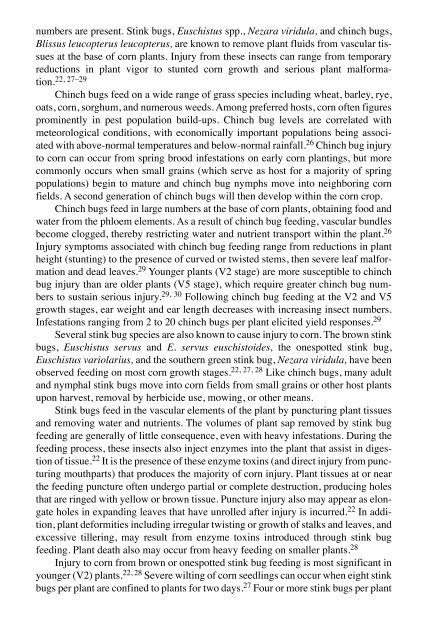Biotic Stress and Yield Loss
Biotic Stress and Yield Loss
Biotic Stress and Yield Loss
- No tags were found...
Create successful ePaper yourself
Turn your PDF publications into a flip-book with our unique Google optimized e-Paper software.
numbers are present. Stink bugs, Euschistus spp., Nezara viridula, <strong>and</strong> chinch bugs,Blissus leucopterus leucopterus, are known to remove plant fluids from vascular tissuesat the base of corn plants. Injury from these insects can range from temporaryreductions in plant vigor to stunted corn growth <strong>and</strong> serious plant malformation.22, 27–29Chinch bugs feed on a wide range of grass species including wheat, barley, rye,oats, corn, sorghum, <strong>and</strong> numerous weeds. Among preferred hosts, corn often figuresprominently in pest population build-ups. Chinch bug levels are correlated withmeteorological conditions, with economically important populations being associatedwith above-normal temperatures <strong>and</strong> below-normal rainfall. 26 Chinch bug injuryto corn can occur from spring brood infestations on early corn plantings, but morecommonly occurs when small grains (which serve as host for a majority of springpopulations) begin to mature <strong>and</strong> chinch bug nymphs move into neighboring cornfields. A second generation of chinch bugs will then develop within the corn crop.Chinch bugs feed in large numbers at the base of corn plants, obtaining food <strong>and</strong>water from the phloem elements. As a result of chinch bug feeding, vascular bundlesbecome clogged, thereby restricting water <strong>and</strong> nutrient transport within the plant. 26Injury symptoms associated with chinch bug feeding range from reductions in plantheight (stunting) to the presence of curved or twisted stems, then severe leaf malformation<strong>and</strong> dead leaves. 29 Younger plants (V2 stage) are more susceptible to chinchbug injury than are older plants (V5 stage), which require greater chinch bug numbersto sustain serious injury. 29, 30 Following chinch bug feeding at the V2 <strong>and</strong> V5growth stages, ear weight <strong>and</strong> ear length decreases with increasing insect numbers.Infestations ranging from 2 to 20 chinch bugs per plant elicited yield responses. 29Several stink bug species are also known to cause injury to corn. The brown stinkbugs, Euschistus servus <strong>and</strong> E. servus euschistoides, the onespotted stink bug,Euschistus variolarius, <strong>and</strong> the southern green stink bug, Nezara viridula, have beenobserved feeding on most corn growth stages. 22, 27, 28 Like chinch bugs, many adult<strong>and</strong> nymphal stink bugs move into corn fields from small grains or other host plantsupon harvest, removal by herbicide use, mowing, or other means.Stink bugs feed in the vascular elements of the plant by puncturing plant tissues<strong>and</strong> removing water <strong>and</strong> nutrients. The volumes of plant sap removed by stink bugfeeding are generally of little consequence, even with heavy infestations. During thefeeding process, these insects also inject enzymes into the plant that assist in digestionof tissue. 22 It is the presence of these enzyme toxins (<strong>and</strong> direct injury from puncturingmouthparts) that produces the majority of corn injury. Plant tissues at or nearthe feeding puncture often undergo partial or complete destruction, producing holesthat are ringed with yellow or brown tissue. Puncture injury also may appear as elongateholes in exp<strong>and</strong>ing leaves that have unrolled after injury is incurred. 22 In addition,plant deformities including irregular twisting or growth of stalks <strong>and</strong> leaves, <strong>and</strong>excessive tillering, may result from enzyme toxins introduced through stink bugfeeding. Plant death also may occur from heavy feeding on smaller plants. 28Injury to corn from brown or onespotted stink bug feeding is most significant inyounger (V2) plants. 22, 28 Severe wilting of corn seedlings can occur when eight stinkbugs per plant are confined to plants for two days. 27 Four or more stink bugs per plant

















